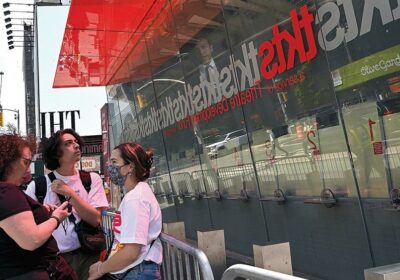Broadway Plots a Comeback: How the Theater Business is Digging Out From COVID Disruptions

Now that omicron is in decline, Broadway optimism is on the rise.
After a bumpy holiday season rife with performance disruptions, show closures and hiatuses due to the highly contagious COVID variant, there are signs of recovery in the New York theater industry — and producers are becoming increasingly bullish about a busy spring season.
“When there was a bump in the road, people stopped and regrouped, but then we safely went on,” says James L. Nederlander of the Nederlander Organization, which owns nine Broadway theaters and also produces the new musical starring Billy Crystal, “Mr. Saturday Night.” “Right now, I think the more noise Broadway can make, the better.”
In late March and April, a whopping 16 shows will open, among them “Mr. Saturday Night,” a splashy revival of “Funny Girl” and the critically acclaimed Pulitzer winner “A Strange Loop,” along with theatrical outings for stars like Matthew Broderick and Sarah Jessica Parker in “Plaza Suite,” Laurence Fishburne and Sam Rockwell in “American Buffalo” and Daniel Craig and Ruth Negga in “Macbeth.”
March and April are usually a time of revival for Broadway, which in the past posted slow sales in January and February before spring-break vacations helped reignite the box office. In the wake of this season’s hobbled holiday weeks (and fueled by Broadway Week two-for-one deals), Broadway grosses and attendance picked up again, hitting 92% capacity for the week ending Feb. 27, with total sales at $23 million across 19 shows.
Sales slipped again for the week ending March 6, and the highs of late February aren’t quite on par with those of 2020 when the comparable week brought in more than $29 million from 26 shows playing to 96% capacity. But to those in the industry, it’s starting to feel like there’s some real progress on the stop-and-start road to recovery — especially since over the past two years, spring and summer have tended to bring a significant drop in COVID infection rates.
“With the weather getting a little better and attendance going up each week, I think people are getting pretty excited about the future,” says Charlotte St. Martin, president of The Broadway League.
Prior to the pandemic, most shows banked on the box office bonanza of year-end holiday weeks, traditionally Broadway’s most profitable. After the long lockdown and the slow restart, that money was more desperately needed than ever. But omicron arrived at exactly the wrong time, sending grosses tumbling to $14.1 million for 22 shows during the week ending Dec. 26. The comparable week in 2019 brought in a massive $55 million across 36 productions.
It remains to be seen whether one of the greatest engines of Broadway sales, city tourism, will rebound as much as anticipated. NYC & Co. has slightly downgraded its 2022 tourism prediction to 56.5 million city visitors, which falls well short of the 66 million tourists recorded in 2019 (the last full year of pre-pandemic data). Still, in recent weeks hotel occupancy rates have begun to climb.
“I guess the biggest question is, how many of the tourists will be here?” says Barbara Whitman, the lead producer of “Strange Loop.” “But the indicators are good.”
Since Broadway reopened in late summer, the box office divide between the haves and the have-nots has widened, with the most prominent names (“Hamilton,” “Wicked,” “The Lion King”) doing big business while many newer titles struggle to draw crowds. That trend seems likely to continue in the coming months, and for shows this spring, the challenge will be to stand out in an unusually crowded slate — while adapting to shifting buying habits in a time of heightened unpredictability.
“Audiences are much more careful about booking six or eight months in advance,” observes Sonia Friedman, the producer of “Funny Girl” and “Harry Potter and the Cursed Child” on Broadway. “It’s much more short term now. We’re not even starting our direct-mail campaign for ‘Funny Girl’ until we’re literally beginning previews.”
At the same time, shows are working to connect with theatergoers outside the traditional demographic of older-skewing, mostly white crowds, as part of an ongoing push to diversify the industry onstage, backstage and in the audience. Nelle Nugent and Ron Simons, two of the lead producers of a new revival of “For Colored Girls Who Have Considered Suicide / When the Rainbow Is Enuf,” describe collaborating with a group of marketers and outreach advisers who each specialize in working with a different demo. “It’s showing up in the sales,” notes Nugent.
Transatlantic producers like Friedman also report promising indicators across the pond. Robert Fox, whose COVID-stalled production of Martin McDonagh’s dark comedy “Hangmen” finally opens in April, expects Broadway to follow London in its revival. “It feels to me like London is probably a few weeks further down the track than Broadway, with [COVID] numbers dropping and people feeling that this particular variant is on the way out and hopefully gone,” he says.
It’s all enough to put a spring into any stateside producer’s step, despite lingering worries about whatever curveball might come next. “Absolutely we are on the rebound, without question,” says Simons of “For Colored Girls,” which delayed performances by a month to give a wider berth to omicron. “Our advance has doubled. Honestly, this is the best I’ve felt about Broadway since before the whole COVID debacle happened.”
Source: Read Full Article